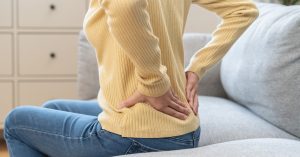Acupuncture for LBPGP 2022 – The BMAS Blog

Inspired by Yang et al 2022.[1]
LBPGP – low back or pelvic girdle pain during pregnancy
NICE – National Institute for Health and Care Excellence
RCTs – randomised controlled trials
QoL – quality of life
LBP – low back pain
PGP – pelvic girdle painkey to acronyms
I did see this review paper in my searches, but it was not until it was highlighted in on Monday 21st November 2022 and the news was relayed to me in clinic the next day that I took more notice.
I guess I am highlighting it now because it got some positive publicity, and it has not been long since NICE ruled against the use of acupuncture in this condition.[2]
The committee agreed that the evidence for acupuncture to treat pelvic girdle pain was mixed, of poor quality and therefore not adequate enough to justify a recommendation that would have a substantial resource impact.[3]
PGP has been mentioned a couple of times already on this blog, so this will be the third post in the . The review includes 10 RCTs and 1040 women.[4–13] Whilst the authors of the paper are based in China (Guangzhou and Kunming), the RCTs included are not. Six come from Sweden, with one each coming from Brazil, Spain, UK, and US.
The pooled outcomes (pain, functional status and QoL) were all highly significantly positive for acupuncture over control; however, there was significant statistical heterogeneity in all of them. This is not necessarily a problem if the heterogeneity can be explained clinically. Here are the major factors that might contribute to heterogeneity in measured effects:
- Pooling of trials with both sham acupuncture and standard care controls
- Pooling of trials of manual acupuncture and ear acupuncture
- Pooling of both penetrating and non-penetrating sham controls
- Inclusion of both LBP and PGP.
It is routine to test for heterogeneity by excluding outlying trials or by performing sensitivity analysis on subgroups. The former worked for the pooled result in the QoL outcome, but there were only 5 trials included and one was an obvious outlier. In the larger pooled analysis for the pain outcome, which included 9 trials, there were no obvious outliers, so the authors chose to exclude each trial, one at a time, and rerun the analysis 9 times. This did not yield any useful insight. It might have been better to do subgroup analysis based on the type of control and the type of intervention. One of these may have come up with a statistically homogeneous result, but the relatively small numbers would risk a lack of power for the pooled result.
Just from eyeballing the forest plot it looks as though an analysis of body acupuncture versus no acupuncture controls would have been positive with a lesser degree of heterogeneity.
Overall, the results look positive and the good news is that there were no observable adverse effects on the newborns.
References
1 Yang J, Wang Y, Xu J, et al. Acupuncture for low back and/or pelvic pain during pregnancy: a systematic review and meta-analysis of randomised controlled trials. BMJ Open 2022;12:e056878. doi:10.1136/bmjopen-2021-056878
2 Recommendations | Antenatal care | Guidance | NICE | Published 19th August 2021. (accessed 2 Dec 2022).
3 Rationale and impact | Antenatal care | Guidance | NICE | Published 19th August 2021. (accessed 2 Dec 2022).
4 Wedenberg K, Moen B, Norling A. A prospective randomized study comparing acupuncture with physiotherapy for low-back and pelvic pain in pregnancy. Acta Obstet Gynecol Scand 2000;79:331–5.
5 Guerreiro da Silva JB, Nakamura MU, Cordeiro JA, et al. Acupuncture for low back pain in pregnancy–a prospective, quasi-randomised, controlled study. Acupunct Med 2004;22:60–7. doi:10.1136/aim.22.2.60
6 Kvorning N, Holmberg C, Grennert L, et al. Acupuncture relieves pelvic and low-back pain in late pregnancy. Acta Obstet Gynecol Scand 2004;83:246–50. doi:10.1111/j.0001-6349.2004.0215.x
7 Elden H, Ladfors L, Olsen MF, et al. Effects of acupuncture and stabilising exercises as adjunct to standard treatment in pregnant women with pelvic girdle pain: randomised single blind controlled trial. BMJ 2005;330:761. doi:10.1136/bmj.38397.507014.E0
8 Lund I, Lundeberg T, Lonnberg L, et al. Decrease of pregnant women’s pelvic pain after acupuncture: a randomized controlled single-blind study. Acta Obstet Gynecol Scand 2006;85:12–9.pm:16521674
9 Elden H, Fagevik-Olsen M, Ostgaard H-C, et al. Acupuncture as an adjunct to standard treatment for pelvic girdle pain in pregnant women: randomised double-blinded controlled trial comparing acupuncture with non-penetrating sham acupuncture. BJOG Int J Obstet Gynaecol 2008;115:1655–68. doi:10.1111/j.1471-0528.2008.01904.x
10 Wang S-M, Dezinno P, Lin EC, et al. Auricular acupuncture as a treatment for pregnant women who have low back and posterior pelvic pain: a pilot study. Am J Obstet Gynecol 2009;201:271.e1-9. doi:10.1016/j.ajog.2009.04.028
11 Ekdahl L, Petersson K. Acupuncture treatment of pregnant women with low back and pelvic pain–an intervention study. Scand J Caring Sci 2010;24:175–82. doi:10.1111/j.1471-6712.2009.00704.x
12 Bishop A, Ogollah R, Bartlam B, et al. Evaluating acupuncture and standard care for pregnant women with back pain: the EASE Back pilot randomised controlled trial (ISRCTN49955124). Pilot Feasibility Stud 2016;2:72. doi:10.1186/s40814-016-0107-6
13 Vas J, Cintado MC, Aranda?Regules JM, et al. Effect of ear acupuncture on pregnancy-related pain in the lower back and posterior pelvic girdle: a multicentre randomised clinical trial. Acta Obstet Gynecol Scand 2019;aogs.13635. doi:10.1111/aogs.13635
Published




